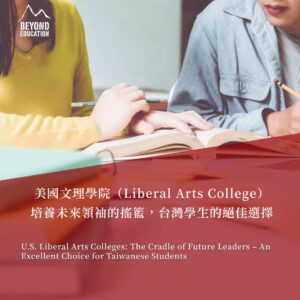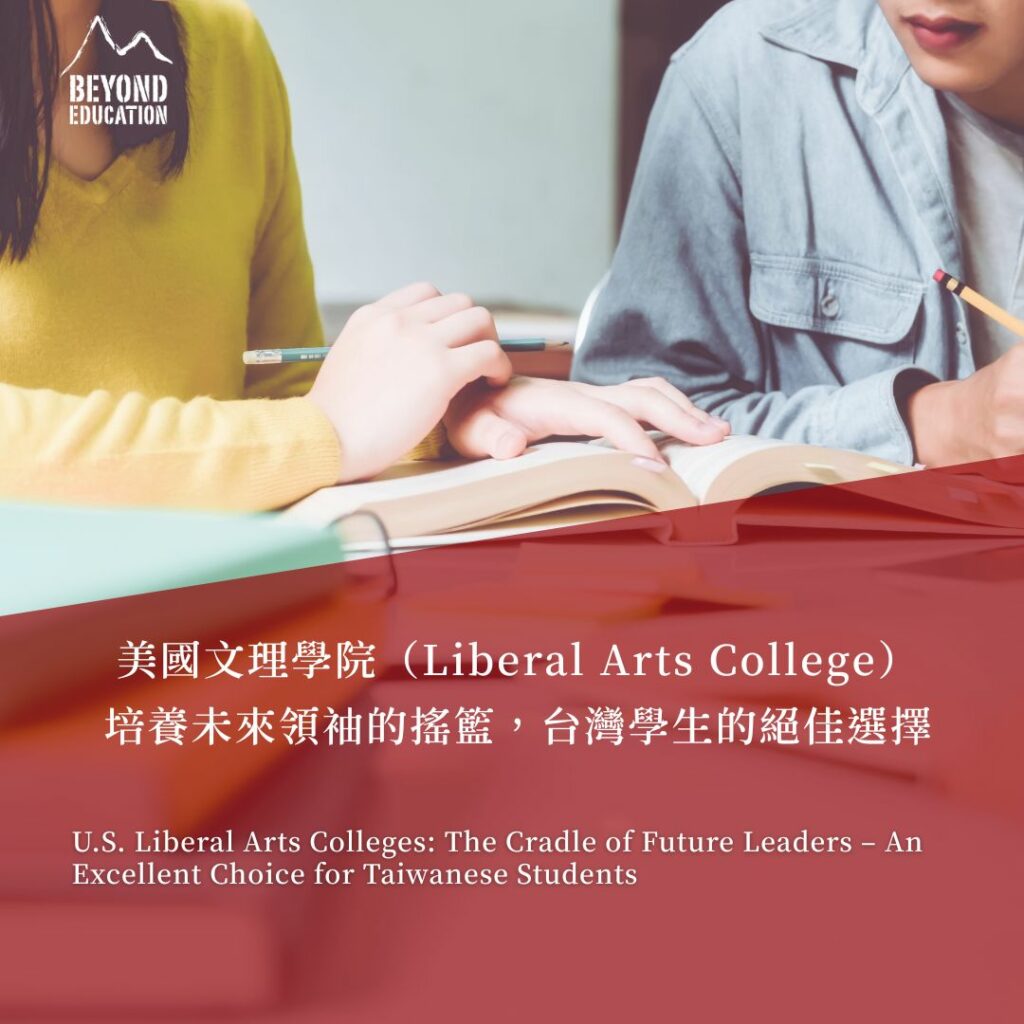
在美國教育體系中,有一類特別且獨具魅力的學校——文理學院(Liberal Arts Colleges)。這些學校的規模比較小,但是他們獨特的教學特色和全面的教育理念,卻吸引了無數許多學生,成為未來的領袖!
許多家長和學生對這類學校比較陌生,但如果是渴望小班教學、與教授有更多互動,或打算將來申請研究所的學生,文理學院可能是比大型大學更適合的選擇!
什麼是美國文理學院(Liberal Arts Colleges)?
文理學院是美國高等教育體系中的一個獨特類型,核心使命是提供博雅教育(Liberal Arts Education)。這種教育不僅僅局限於人文藝術學科,而是涵蓋了人文、社會科學、自然科學和數學等多個領域,強調跨學科學習與全面發展。其目標是培養學生的深度思辨、廣泛學習及應對未來挑戰的能力。
在美國,文理學院被視為精緻且高質量的本科教育代表。這些學校規模較小,歷史悠久,尤其是排名前 50 的文理學院,許多已有百年以上的辦學歷史,在當地擁有極高聲譽。它們注重培養學生的綜合素質,強調文化品味與社會修養,目標是讓學生成為具備獨立思考和開闊視野的現代公民。
而文理學院的教育理念為:
- 廣博學識:學生需涉獵人文、社會科學、自然科學等多個領域。
- 批判思考:培養獨立分析與解決問題的能力。
- 跨領域能力:訓練學生能夠在不同領域間靈活應用知識。
美國文理學院的 4 大特色
1. 精緻小班教學
文理學院通常規模較小,學生人數從數百人到兩三千人不等。這表示為低師生比(常見為1:7至1:10),教授認識並關心每一位學生,課堂上多為討論式而非單向講授。學生無法「隱形」,必須積極參與,這對能力成長是很重要的部分。
2. 探索式學習與課程彈性
文理學院鼓勵學生在大一、大二廣泛探索各種學科,從哲學、社會學到物理、計算機科學都可以嘗試,直到大三再決定主修。這非常適合興趣多元、還未確定職涯方向的學生。
3. 核心課程(Core Curriculum)
無論最終主修哪一個科系,所有學生都必須修讀一系列涵蓋人文、藝術、社會科學和自然科學的核心課程。以確保每位畢業生都擁有扎實的知識基礎和多元的視角,能夠以跨領域的方式思考問題。
4. 強調軟實力的淬煉
文理學院極度注重寫作、口語表達、邏輯思辨和解決複雜問題的能力。幾乎每門課都有大量的閱讀、寫作和小組報告要求。這種「磨練」出來的軟實力,正是未來職場中最核心、最無可替代的競爭力。
就讀文理學院的巨大優勢
了解文理學院的基本定義之後,我們來深入探討文理學院的優勢,也包含針對國際學生的獨特好處。
1. 高額獎學金機會:CP 值超高的投資
美國文理學院對於國際學生的獎學金現狀極為慷慨,許多文理學院擁有驚人的捐贈基金。為了吸引優秀的國際學生,他們通常更願意提供優渥的獎助學金。對於許多家庭來說,選擇文理學院最終的自負額可能遠低於一所排名較低的綜合大學,CP 值非常高。
2. 「家」的歸屬感:快速適應異國文化
對遠赴重洋的國際學生來說,孤獨感和文化隔閡是最大的挑戰。文理學院緊密的校園社群就像一個大家庭,學生和教授之間關係密切,同學之間也更容易建立深厚的友誼。這種支持系統能有效幫助國際學生融入美國生活,減少「文化休克」帶來的不適!
3. 領導力養成:打造閃亮的履歷
在動輒數萬人的綜合大學裡,一個新生要成為社團領導人或參與重要研究計劃實在是比登天還難!但在文理學院,因為人數少,每個學生都有大量機會參與社團、競選學生代表、擔任教授的研究助理。這意味著在畢業時,能累積出遠比同齡人更豐富、更獨特的履歷,在申請研究所或求職時能夠脫穎而出。
4. 頂尖研究所的黃金跳板
如果夢想進入醫學、法律、商學等頂尖研究所,文理學院其實是絕佳起點。其紮實的學術訓練備受推崇,而教授與學生關係密切,代表著你能拿到非常個人化且強力的推薦信。美國官方「國家科學基金會( NSF )」年度「博士學位獲得者調查( Survey of Earned Doctorates, SED )」資料顯示,文理學院畢業生進入博士課程的比例遠高於綜合大學。
5. 強大的校友網絡(Alumni Network)
文理學院的校友通常對母校有極強的歸屬感和忠誠度。這個緊密的網絡在職場上會形成強大的互助系統,學長姐們非常樂意為畢業生提供機會引薦、職業建議和人生導引。
從文理學院走向世界巔峰:見證影響力的誕生
文理學院的畢業生不僅僅是學術上的佼佼者,他們更是各領域的革新者和領導者。從史蒂夫・賈伯斯、雪柔・桑德伯格到巴拉克・歐巴馬、希拉蕊·柯林頓,這些成功人士的名字,象徵著文理學院培養出來的優秀人才,正以非凡的影響力,改變著世界!
破解對文理學院的「迷思」
儘管說明了文理學院的優勢,但相信許多家長和學生可能心中還是有些疑慮。
讓我們直接面對這些問題!
迷思一:「文理學院排名低,名氣不夠響亮?」
事實: 這是最常見的誤解。美國有獨立的文理學院排名(U.S. News National Liberal Arts Colleges Ranking),諸如威廉姆斯學院(Williams)、阿默斯特學院(Amherst)、斯沃斯莫爾學院(Swarthmore)、波莫納學院(Pomona)等頂尖文理學院,這些學校的錄取難度、學生質量和聲譽,常與常春藤盟校並駕齊驅。在美國高等教育圈內,這些名字是「精英教育」的代名詞。更重要的是,企業招聘時越來越看重個人能力而非校名。
迷思二:「教得太廣,會不會不專精,不好找工作?」
事實: 恰恰相反。在 AI 時代,單一技能的價值正在快速折舊。企業最渴求的正是文理學院所培養的——能溝通、會思考、可適應變局、能解決複雜問題的「T型人才」。他們擁有廣博的知識基礎(T的橫軸)和一樣以上的專業深度(T的縱軸)。數據顯示,文理學院畢業生的就業率和長期職涯發展都非常亮眼。
迷思三:「學校那麼小,資源會不會很少?」
事實: 關鍵在於「人均資源」。正因為學校小,每個學生能分配到的資源反而更多。例如,大型大學的研究經費總額可能很高,但分攤到每個學生身上就少了。文理學院則能提供本科生直接使用頂尖實驗設備、參與前沿研究計畫的機會。
超越教育的觀點
在這個變動劇烈的時代,我們無法預測十年後哪些工作會消失,哪些新行業會誕生。唯一能確定的,是那些擁有批判性思維、創造力、溝通力和終身學習能力的人,將永遠立於不敗之地。美國文理學院的教育,正是為了培養這樣的人才而設計的。
在超越教育,我們協助學生找到最適合自己的學習環境,並針對文理學院與大學的差異,提供專業建議與申請策略。如果您想深入了解美國文理學院,或規劃完整的升學路線,歡迎與我們聯繫,一起打造孩子的最佳留學藍圖。
U.S. Liberal Arts Colleges: The Cradle of Future Leaders – An Excellent Choice for Taiwanese Students
Within the American education system, there is a unique and captivating type of institution—Liberal Arts Colleges. These schools are relatively small in size, but their distinctive teaching features and comprehensive educational philosophy attract countless students and shape them into future leaders!
Many parents and students are less familiar with this type of school. However, for those who desire small class sizes, more interaction with professors, or plan to apply to graduate school in the future, liberal arts colleges may be a more suitable choice than large universities!
What are U.S. Liberal Arts Colleges?
Liberal arts colleges are a unique category within the American higher education system, with a core mission of providing a liberal arts education. This education is not limited to the humanities and arts but encompasses a wide range of fields, including humanities, social sciences, natural sciences, and mathematics, emphasizing interdisciplinary learning and holistic development. The goal is to cultivate students’ critical thinking, broad learning, and ability to tackle future challenges.
In the U.S., liberal arts colleges are regarded as representatives of refined and high-quality undergraduate education. These schools are typically small in scale with long histories, especially the top 50 liberal arts colleges, many of which have been operating for over a century and enjoy excellent reputations locally. They focus on developing students’ comprehensive qualities, emphasizing cultural appreciation and social refinement, with the aim of nurturing students into modern citizens with independent thinking and broad perspectives.
The educational philosophy of liberal arts colleges includes:
– Broad Knowledge: Students are required to explore multiple fields, including humanities, social sciences, and natural sciences.
– Critical Thinking: Cultivating the ability to analyze and solve problems independently.
– Interdisciplinary Skills: Training students to flexibly apply knowledge across different fields.
4 Key Features of U.S. Liberal Arts Colleges
- Small Class Sizes
Liberal arts colleges are typically small in scale, with student populations ranging from a few hundred to two or three thousand. This results in low student-to-faculty ratios (commonly 1:7 to 1:10), where professors know and care about each student. Classes are often discussion-based rather than lecture-based. Students cannot remain “invisible” and must actively participate, which is crucial for their growth.
- Exploratory Learning and Curriculum Flexibility
Liberal arts colleges encourage students to explore various disciplines broadly during their first and second years, from philosophy and sociology to physics and computer science. Students declare their majors only in their third year. This is ideal for students with diverse interests who have not yet decided on a career path.
- Core Curriculum
Regardless of their eventual major, all students are required to take a series of core courses covering humanities, arts, social sciences, and natural sciences. This ensures that every graduate has a solid knowledge base and diverse perspectives, enabling them to think about problems interdisciplinary.
- Emphasis on Soft Skills
Liberal arts colleges place extreme importance on writing, oral expression, logical reasoning, and problem-solving skills. Nearly every course involves extensive reading, writing, and group projects. These honed soft skills are the most core and irreplaceable competencies in the future workplace.
Significant Advantages of Attending a Liberal Arts College
After understanding the basic definition of liberal arts colleges, let’s delve into their advantages, including unique benefits for international students.
- Generous Scholarship Opportunities: A High-Value Investment
U.S. liberal arts colleges are extremely generous with scholarships for international students. Many have impressive endowment funds and are often more willing to offer substantial scholarships to attract outstanding international students. For many families, the out-of-pocket cost of attending a liberal arts college may be far lower than that of a lower-ranked comprehensive university, making it a highly cost-effective choice.
- A Sense of “Home”: Quick Adaptation to a Foreign Culture
For international students studying far from home, loneliness and cultural barriers are the biggest challenges. The close-knit campus community of a liberal arts college feels like a large family, with strong relationships between students and professors and deeper friendships among peers. This support system effectively helps international students integrate into American life and reduces the discomfort of “culture shock.”
- Leadership Development: Building an Impressive Resume
In comprehensive universities with tens of thousands of students, it is incredibly difficult for a freshman to become a club leader or participate in important research projects. However, at liberal arts colleges, the small size means every student has ample opportunities to join clubs, run for student representative positions, or work as a research assistant for professors. This allows students to accumulate a more丰富 and unique resume by graduation, helping them stand out when applying to graduate school or jobs.
- A Golden Stepping Stone to Top Graduate Schools
If dreaming of entering top graduate programs in medicine, law, or business, liberal arts colleges are an excellent starting point. Their rigorous academic training is highly respected, and the close professor-student relationships mean students can obtain highly personalized and strong recommendation letters. According to the U.S. National Science Foundation’s annual “Survey of Earned Doctorates (SED),” graduates of liberal arts colleges enter doctoral programs at a much higher rate than those from comprehensive universities.
- Strong Alumni Network
Alumni of liberal arts colleges typically have a strong sense of belonging and loyalty to their alma maters. This tight-knit network forms a powerful support system in the workplace, where alumni are often very willing to provide opportunities, career advice, and mentorship to recent graduates.
From Liberal Arts Colleges to Global Leadership: Witnessing the Birth of Influence
Graduates of liberal arts colleges are not only academic achievers but also innovators and leaders in various fields. From Steve Jobs and Sheryl Sandberg to Barack Obama and Hillary Clinton, these successful individuals symbolize the exceptional talent nurtured by liberal arts colleges, who are changing the world with extraordinary influence!
Debunking “Myths” About Liberal Arts Colleges
Despite highlighting the advantages of liberal arts colleges, many parents and students may still have concerns. Let’s address these questions directly!
Myth 1: “Are liberal arts colleges low-ranked and not prestigious enough?”
Fact: This is the most common misconception. The U.S. has an independent ranking for liberal arts colleges (U.S. News National Liberal Arts Colleges Ranking). Top liberal arts colleges such as Williams, Amherst, Swarthmore, and Pomona often rival Ivy League schools in terms of admission difficulty, student quality, and reputation. Within American higher education circles, these names are synonymous with “elite education.” More importantly, employers increasingly value individual abilities over school names.
Myth 2: “Is the education too broad? Will it lack specialization and make finding a job difficult?”
Fact: Quite the opposite. In the AI era, the value of single skills is rapidly diminishing. What companies most desire are exactly the qualities liberal arts colleges cultivate—”T-shaped talents” who can communicate, think critically, adapt to change, and solve complex problems. They possess broad knowledge (the horizontal bar of the T) and deep expertise in at least one area (the vertical bar of the T). Data shows that employment rates and long-term career development for liberal arts college graduates are highly impressive.
Myth 3: “Are the schools too small to have sufficient resources?”
Fact: The key lies in “per capita resources.” Precisely because the schools are small, each student has access to more resources. For example, while large universities may have higher total research funding, the amount per student is often lower. Liberal arts colleges, however, can offer undergraduates direct access to top-tier laboratory equipment and opportunities to participate in cutting-edge research projects.
A Perspective Beyond Education
In this rapidly changing era, we cannot predict which jobs will disappear or which new industries will emerge in ten years. The only certainty is that those with critical thinking, creativity, communication skills, and lifelong learning abilities will always remain invincible. The education provided by U.S. liberal arts colleges is designed precisely to cultivate such talents.
At Beyond Education, we help students find the learning environment that best suits them and provide professional advice and application strategies regarding the differences between liberal arts colleges and universities. If you would like to learn more about U.S. liberal arts colleges or plan a comprehensive academic pathway, feel free to contact us. Let’s work together to create the best study abroad blueprint for your child!
